Top News
September 24, 2011 Ryukyu Shimpo
In his first meeting with Japanese Prime Minister Yoshihiko Noda on the sidelines of the U.N. General Assembly in New York, U.S. President Barack Obama is reported as having told Noda, “A period in which results must be seen in the relocation plan is approaching.” However, the validity of this quote is doubted.
When asked after the U.S.-Japan summit meeting about this remark by U.S. President Barack Obama, in a less than certain tone, Noda said, “The president said he would like to see progress on the relocation issue.”
Assistant Secretary of State Kurt Campbell gave the press corps an explanation about Obama’s mentioning “a period in which results must be seen in the relocation plan,” but this explanation conflicts with Noda’s acknowledgement.
In addition to the U.S. President and Japanese Prime Minister, Foreign Minister Koichiro Gemba and U.S. Secretary of State Hillary Clinton attended the meeting on September 21. They were accompanied by officials from the Ministry of Foreign Affairs of Japan and the United States Department of State.
After the meeting, Campbell talked to the media, saying, “Both sides understand we are approaching a period where you need to see results. That was made very clear by the President.”
Following this, Japanese news media reported that President Obama put visible pressure on Japan’s premier with regard to the ongoing problem of relocation of U.S. Marine Corps Air Station Futenma.
Japanese news media also reported that Obama putting pressure on the Japanese prime minister regarding the relocation plan reflected the “American side’s frustration with the situation in which because of the federal budget deficit the U.S. Congress is questioning the feasibility of the U.S. Marine Forces Transfer Plan from Okinawa to Guam being linked with the relocation of the base at Futenma.”
According to people involved, Noda did not seem to be clear regarding the remark Obama was reported to give in response to a question from the press about whether or not the president was demanding results in the relocation plan.
With regard to his talks with the president on the Futenma issue, Noda said, “I said that I would do my best to gain the understanding of the people of Okinawa regarding the relocation issue while trying to reduce Okinawa’s Base-Hosting Burden. Mr. Obama said that he would like to see progress on the relocation issue.”
(English Translation by T&CT, Mark Ealey)
Go To Japanese
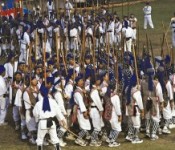
September 25, 2011 Ryukyu Shimpo
A big harvest festival, in which Maitreya or future Buddha is received in Year of the Hare or the Year of the Rooster is held once every six years, this time in Umai, Bin, Tomigusuku City on September 24. Machibo, a type of bojutsu (staff-wielding) dating back about 200 years was also performed.
Spectators were excited when the gong was struck to signal the start of machibo as about 160 men entered the venue.
Two-men bojutsu kata called tanker bo, as well as three-men and five-men versions were performed. The spectators were generous in their applause for the brave performances of the men who ran and jumped with sticks. In the final phase of the festival the participants shouted Hya-Hya to the sound of a gong. Two human chains called ubo and mebo merged into one, and the spectators erupted in applause as the participants raised their sticks.
Construction worker 30 year-old Masaki Toma, who participated in machibo for the third time, proudly said, “I was really excited about the festival. It is a great tradition inherited from our ancestors.”
Office-worker 32 year-old Satsuki Yoshimoto, who visited the festival with ten of her relatives, said, “Although fewer people took part this year, they all worked in with each other perfectly and looked tremendous.”
The festival including a michijune, machibo and eisa was also held on September 25.
(English Translation by T&CT, Mark Ealey)
Go To Japanese

Go To Video
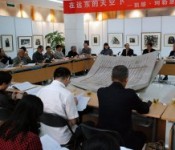
September 18, 2011 Shoichiro Yonamine, reporter of Ryukyu Shimpo, in Beijing
An exhibition of art works by Kathe Kollwitz in the possession of the Sakima Art Museum is being held at the Lu Xun Museum in Beijing from September 17 to October 9 to celebrate the 130th anniversary of birth of Lu Xun, a major Chinese writer of the 20th century.
Kathe Kollwitz is a German painter, printmaker, and sculptor whose works were highly influential in the first half of the 20th century, embracing as they did the victims of poverty, hunger, and war.
A symposium was also held in relation to the exhibition. Experts from Okinawa, China, South Korea and Taiwan participated, discussing how the messages that Kollwitz’s works of art deliver overlap with the thinking of Okinawan people, who have experienced war and have resisted oppression. They further develop discussion on how East Asian countries that have experienced colonialism might build relationships in the new era.
It is said that Kollwitz’s thinking and artistic persona was strongly influenced by Lu Xun.
Fifty-eight of her works, including block prints and sculptures, are displayed in the exhibition which many people have enjoyed viewing.
Sun Ge, a researcher of the Literature Research Institute of the China Academy of Social Studies, doubts that the Chinese people of today would be able to get back to the kind of profound self-observation advocated by Lu Xun, saying, “We would like to start again with Okinawa as a springboard.”
Sun Ge continued, “Despite having encountered tremendous hardships, the people of Okinawa do not seek to express themselves in the context of a sad existence, but rather they create humanistic principles on a scale larger than the islands in which they live – they are unshaken by despair. ‘The power of the wounded,’ which Kollwitz expressed through her works of art, can also be seen in the thinking of Okinawan people.”
Hong Song Dam, a South Korean artist who works with woodcuts and is an acclaimed member of the Minjung art movement, the South Korean political and populist art movement that used visual arts to resist a military government in the 1980s, said, “What works of art represent can vary depending on who collects them. I would like people to consider why so many of Kollwitz’s art works are in the possession of the Sakima Art Museum. I am paying close attention to how China, as a superpower, reacts to the pain suffered by the Okinawan people.”
(English Translation by T&CT, Mark Ealey)
Go To Japanese
September 16, 2011 Ryukyu Shimpo
On September 16, Defense Minister Yasuo Ichikawa had his first talks over the phone with his counterpart Leon Panetta, the United States Secretary of Defense. Ichikawa announced it at his press conference that during their talks they were united with regard to pressing ahead with the plan to relocate the Futenma Air Station to Henoko in Nago City, as per the Japan-U.S. agreement. According to Ichikawa, Secretary of Defense Panetta stated that the Futenma relocation is an important matter to advance in the context of the Japan-U.S. alliance, and he urged Ichikawa to move ahead on the Japan-U.S. agreement.
According to Ichikawa, Secretary of Defense Panetta said that the United States Government will strive to achieve concrete progress on the relocation, and he asked for the Japanese Government’s cooperation. With regard to their talks, Ichikawa said, “We agreed to move forward [on the relocation issues] in order to deepen the alliance. It was a friendly and positive meeting.”
At the same time, with regard to Under-Secretary of Defense Ashton Carter’s suggestion that the current plan be reviewed in the Senate Armed Services Committee, Ichikawa stated, “I know about that, but we only look to work in accordance with formal agreements.” He stressed that the Japanese Government will not consider reviewing the current plan.
(English Translation by T&CT, Mark Ealey)
Go To Japanese
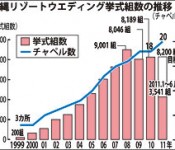
September 16, 2011 Ryukyu Shimpo
According to figures released by the Cultural Tourism and Sports Division of the Okinawa Prefectural Government (OPG) on September 15, the number of couples who held wedding ceremonies in resort hotels and other facilities in Okinawa decreased by 10.5% (415 couples) in the first half of 2011 (from January to June) in comparison with the same period of the previous year. There have been many cancellations or postponements of such bookings after the Great East Japan Earthquake. During the second half of the year, the number is expected to increase from overseas thanks to favorable exposure in the likes of a popular Korean drama that features a scene of an Okinawa resort wedding, the introduction of a new flight between Beijing and Naha, and the increase in the number of flights between Shanghai and Naha.
The figures are based on data submitted by 29 companies that responded to a survey of 61 firms involved with resort weddings in the prefecture.
In terms of regions, newly married couples from Kanto accounted for about 40% of the total with the largest numbers. There were 83 couples from overseas, a decrease of 6.7% (six couples) on the number for the same period of the previous year.
The average cost of wedding ceremonies and receptions was about 910000 yen. The wedding itself is about 320000 yen. By using the average number of people attending ceremonies and reception banquets we can calculate that the total expenditure on Okinawa resort weddings to be at least about 6.6 billion yen.
The most popular style of wedding is the “Chapel Wedding,” preferred by approximately 90% of the couples. In addition, weddings known as “Photo Weddings,” which are carried out on the sea or on beautiful sandy beaches, are becoming increasingly popular. The OPG has set a goal of 8200 couples a year (January to December) for resort weddings. An official at the prefectural office stated, “It will be difficult to achieve the goal but things are looking up so we will do our best.”
(English Translation by T&CT, Mark Ealey)
Go To Japanese
September 15, 2011 Ryukyu Shimpo
According to U.S. official telegrams disclosed by WikiLeaks, following the visit of two mine-countermeasure vessels of the U.S. Navy in Japan to Sonai Port, a civilian port on Yonaguni Island on June 2007, Kevin Maher, the former director of the State Department’s Office of Japan Affairs and former consul general in Okinawa Prefecture, communicated to the U.S. government that “Yonaguni Island, as the Japanese territory forward located closest to Taiwan, foreseeably could become a hub for mine countermeasures operations in the event of a contingency in the Taiwan Straits.”
Although the U.S. Navy had publically defined the purpose of the port call as being to promote friendly relations and to give the crew an opportunity to rest, this official telegram reveals that they collected information on whether or not they could use a civilian port on Yonaguni Island as a hub for mine countermeasures operations in the event of an emergency situation in the Taiwan Straits.
The official telegram about the visit by two U.S Navy mine-countermeasure vessels to Sonai Port, located in the northern part of Yonaguni Island, from June 24 to 26 in 2007, was sent to the U.S. government on June 27, 2007.
The Okinawa Prefecture Government Port Authority urged the United States to show self-restraint before the visit and the mayor of Yonaguni Town even expressed his opposition to the visit.
In his official telegram, Maher wrote, “This port call to Japan’s westernmost point, located only seventy miles from Taiwan, was operationally significant.” With regard to Sonai Port, Maher highly evaluated its operational functionality, saying, “We determined that Sonai Port is deep enough for safe access by USN mine countermeasures ships, and that in all likelihood four mine countermeasures ships could fit into the port at one time.”
Referring to the fact that Sonai Port is located near Yonaguni Airport, Maher wrote, “Yonaguni Island also has a commercial airfield less than two miles from Sonai Port, with a 2,000 meter runway and a small tarmac. If helicopters used this airfield in support of mine countermeasures ships, Yonaguni Island, as the Japanese territory forward located closest to Taiwan, foreseeably could become a hub for mine countermeasures operations in the event of a contingency in the Taiwan Straits.”
Maher also mentioned that citizens who protested against the visit proceeded directly to the side of the vessels, preventing the crewmembers from landing at the port. He described access control to the dock area by the Okinawa Prefectural Government (OPG) and Okinawa Prefectural Police (OPP) as being “poor.”
Maher stated, “It is not entirely clear to us whether this poor access control was the result of the Port Authority personnel’s inexperience, incompetence, or a decision made by the OPG not to cooperate. (Prior to the port call, the OPG had asked that the U.S. show “self restraint” and cancel it.) It was probably a combination of all three.” Maher continued, “We advised the Ministry of Foreign Affairs (MOFA) representatives on site, and the OPP and OPG Port Authority, that access control and force protection must be improved in the future, stressing that this is a safety issue both for our ships and for the local people and the demonstrators themselves.”
Maher wrote, “The [Yonaguni City] Assembly members who voted in support attended a welcome dinner hosted by a local resident for the ships’ officers, and stressed repeatedly to us that the protestors were ‘outsiders’ and that USN (United States Navy) ships are welcome in Yonaguni,” “Two of the Yonaguni City Assembly members who supported the visit told the Consul General that they hope such ship visits will become routine. When asked what frequency would be desirable, they responded that at least once a year would be good.”
(English Translation by T&CT, Mark Ealey)
Go To Japanese
September 14, 2011 Ryukyu Shimpo
On September 13, the Okinawa Prefecture Department of Welfare and Health announced the number of people now aged 100 years or more and the list of the oldest people in the prefecture.
As of September 15, there were 920 centenarians, down two from the previous year.
With regard to the number per 100000 people in the prefecture, the figure for Okinawa was 66.04, down 0.67 from the previous year. This is the third highest in Japan after Shimane Prefecture in first place with 75.70, and Kochi Prefecture in second place with 67.58.
Okinawa had monopolized first place since 1973, but dropped to second in 2010.
A spokesperson of the Longevity Policy Office of the department explained this, saying, “The reason for this drop in the rankings may be that while the overall population of Shimane and Kochi has decreased, that of Okinawa has increased by 11000.”
As for the gender ratio of people aged 100 or more living in Okinawa, the number of women was 803, representing 87.2% of the total, while the number of men was 117.
The oldest woman is a 113 year-old resident of Okinawa City and the oldest man a 109 year-old resident of Urasoe City.
In 2011, 329 elderly people (280 women and 49 men) are expected to turn 100 years old, an estimated increase of 22 people over the previous year.
In the breakdown of centenarians by municipalities, Naha City claimed the top spot with 64, followed by Itoman City with 25, and Urasoe City and Okinawa City, which both have 19 people.
(English Translation by T&CT, Mark Ealey)
Go To Japanese
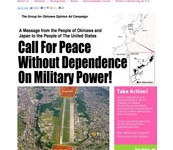
September 22, 2011 Ryukyu Shimpo
From September 21 to 22, volunteers from citizen groups opposing the relocation of the Futenma Air Station to Henoko put a newspaper advertisement in the international news section of New York Times electronic edition, the most popular American online newspaper website. In the ad they demanded the immediate closure of Futenma Air Station and opposed its relocation to any other site within the prefecture.
They timed this to coincide with Japanese Prime Minister Yoshihiko Noda’s four-day visit to the United States, which began on September 21.
Although the volunteers had put newspaper advertisements in local newspapers and national newspapers in Japan, this was the first time that they have put an advertisement in the electronic edition of an American newspaper.
In the advertisement, they pointed out that the U.S. Congress has drastically cut military spending in order to reduce the federal budget deficit, stating, “Futenma Air Station is putting America’s friends in danger. Closing Futenma will save Americans money and will create American jobs when the Marines come home.”
Ai Ikuta, one of the advocates for putting newspaper advertisement in the New York Times electronic edition, and the person who coordinated the volunteers, said, “We can get people all over the world to read our message by putting newspaper advertisement in the New York Times electronic edition. I would like our grass-roots movement to spread through the advertisement.”
(English Translation by T&CT, Mark Ealey)
Go To Japanese
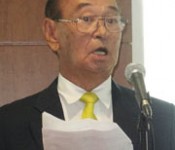
September 21, 2011 Ryukyu Shimpo
In the afternoon of September 19, at George Washington University in Washington DC, Okinawa Governor Hirokazu Nakaima delivered a lecture on the Futenma relocation issue.
During the question and answer period after his lecture, when he was asked about a Japan-U.S. deal on the realignment package linking the U.S. Marine Forces Transfer Plan from Okinawa to Guam and the return of six military facilities located south of the U.S. Kadena Air Force Base with the relocation of the base at Futenma, Nakaima said, “There is no logic to that. The United States should return such facilities soon as they are no longer necessary.”
This is the first time that Nakaima has been to the United States to reject a Japan-U.S. deal on the U.S. military realignment package.
In May 2010, both the U.S. and Japanese governments confirmed that they would implement the road map for U.S. military realignment in Japan that links the relocation of the Futenma base with the return to Japan of military facilities located south of the U.S. Kadena Air Force Base.
While Okinawa Prefecture seeks the swift return of military-occupied land without any link to the package, the position of both governments is to persist with its implementation.
Former Japanese defense minister Toshimi Kitazawa said, “The American side insists that the road map for the realignment of U.S. military forces in Japan should be implemented in its current form.”
Nakaima explained that about 74% of U.S. military facilities in Japan are concentrated in Okinawa, and likened that to “having such military facilities right in the center of New York City.” He talked about the dangerous nature of the Futenma Air Station, and from there said, “There is no need to link the relocation of the Futenma Air Station and the return of other U.S. military bases. The two governments should stop doing deals and return the bases promptly.”
Nakaima insisted that both parties should move towards the early return of U.S. military facilities and not link that to the current Futenma relocation plan that has become deadlocked.
(English Translation by T&CT, Mark Ealey)
Go To Japanese
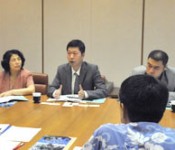
September 21, 2011 Ryukyu Shimpo
A Chinese delegation, including representatives of the China Investment Association and investment-related companies visited the Okinawa Prefectural Government (OPG) Office on September 20 to exchange views with the people responsible for industry policy, industrial site promotion, transport policy and various other sections.
OPG officials explained its policy and the current situation in which it has been promoting and attracting investment from overseas with tax incentives, including subsidies for companies and data centers that have been moving from other areas of Japan to Okinawa since the Great East Japan Earthquake. They also emphasized that the All Nippon Airways (ANA) international cargo hub project based at Naha Airport gives Okinawa logistical advantages and suggested that Chinese companies would benefit by setting up in Okinawa.
Members of the Chinese delegation showed interest in the Okinawan tourism or resort industry, saying, “In China, our government has regulated overheating investment, but we have sufficient funds and would like to actively expand our business overseas.”
The person responsible for the Bank of East Asia, the largest Chinese bank in Hong Kong, was among the delegation, which arrived on September 18, and visited the Okinawa IT Shinryo Park on September 20.
(English Translation by T&CT, Mark Ealey)
Go To Japanese
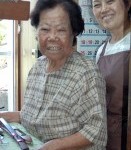
September 19, 2011 Ryukyu Shimpo
Sitting on a weaving machine by the window where she can look out over a patch of loofah gourds, 90 year-old Toshi Oshiro of the Motobu district of Haebaru Town works away skillfully adding kasuri splash-patterns to the textile. She is still actively engaged in developing the Ryukyu kasuri textile that is the local product of Haebaru, and is a master of every aspect of the process. She employs two hand-weavers at her studio and sells the products to exponents of ryubu (Ryukyuan dance) and to wholesale stores in Shiga prefecture. She has 77 years of professional experience in kasuri since becoming involved after finishing elementary school. “My family made Ryukyu kasuri at home and I was interested in it, so I naturally started to help. I just continued making it,” she said in a lighthearted manner.
Fifty-seven year-old Tomoko, who lives with Toshi, started making kasuri in earnest after marrying Masanori (61 years old), second son of Toshi, when she started learning the craft from her mother-in-law. Koji, Toshi’s 30 year-old grandson also started to learn how to make it three years ago, so kasuri craftwork now spans three generations of the Oshiro family.
Toshi was born in the Kyan district near the Motobu area of Haebaru Town. After the Battle of Okinawa, when she was 26 years old, she married Kosei Oshiro, who passed away at the age of 86. In addition to weaving, she worked with her husband washing the glue attached to the cloth. They raised four sons and one daughter. She looked back on her life saying, “We worked for a living. Kosei helped me, so I could raise the children.” In 1988, she was designated a traditional craftsperson.
She wakes up at 6:00am every morning and reads the newspaper before starting on the preparatory work such as making the yarn, tying kasuri and dyeing it. Then she sits on the machine in the afternoon to do the weaving. She enjoys playing gateball at 3:00pm as part of her daily routine. “I enjoy it everyday,” she said smiling. She gets by without glasses except for when she is on the weaving machine, and has no particular illnesses. “When I have a cold, I drink a nutritional supplement and bounce back if I rest in bed for a day,” she laughed.
Daughter-in-law Tomoko emotionally said, “She is an inspiration to us.” Koji grew up listening to the sound of his mother’s handloom. He looked over at his mother respectfully, saying, “She and finds out what our customers want in their products, and creates works that match their needs. It is marvelous that she does that so naturally.”
Toshi again said, “I am happy now that I have managed to get successors in place.”
(English Translation by T&CT, Mark Ealey)
Go To Japanese








 Webcam(Kokusai Street)
Webcam(Kokusai Street)


